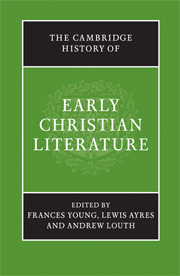Book contents
- Frontmatter
- PART ONE The Beginnings: The New Testament to Irenaeus
- A LITERARY GUIDE
- B CONTEXT AND INTERPRETATION
- 7 Social and historical setting
- 8 Articulating identity
- 9 Christian teaching
- 10 Conclusion: towards a hermeneutic of second-century texts
- PART TWO THE THIRD CENTURY
- PART THREE FOUNDATION OF A NEW CULTURE: FROM DIOCLETIAN TO CYRIL
- Bibliographies
- Index
- Map: The Roman Empire in the late fourth century AD"
- References
8 - Articulating identity
from B - CONTEXT AND INTERPRETATION
Published online by Cambridge University Press: 28 March 2008
- Frontmatter
- PART ONE The Beginnings: The New Testament to Irenaeus
- A LITERARY GUIDE
- B CONTEXT AND INTERPRETATION
- 7 Social and historical setting
- 8 Articulating identity
- 9 Christian teaching
- 10 Conclusion: towards a hermeneutic of second-century texts
- PART TWO THE THIRD CENTURY
- PART THREE FOUNDATION OF A NEW CULTURE: FROM DIOCLETIAN TO CYRIL
- Bibliographies
- Index
- Map: The Roman Empire in the late fourth century AD"
- References
Summary
By the last decades of the first century, the Christian communities around the Mediterranean basin had entered upon a process that would, over a period of two or more centuries, produce a relatively stable, widely shared, and socially embodied sense of who they were and what they stood for. This identity-forging process was impelled by at least two related circumstances, and it was strongly encouraged, to say the least, by others. One of its essential conditions lay in the tendency of these communities, however different from one another in their versions of Christian faith and life, to see themselves as constituting a single people, scattered though their outposts were. The literature of the New Testament and the Apostolic Fathers, and of later periods as well, indicates how natural, not to say habitual, it was for these communities and their representatives to expect one another’s recognition and to interfere in one another’s business. From the beginning, then, the history of Christianity was a history of controversy. It exhibits not only a high incidence of disagreement or misunderstanding within and among churches, but also a prevailing sense of mutual involvement and even mutual dependence; and these two factors conspired together to stimulate attempts to arrive at a common public mind and a shared practice.
Correlative with this quarrelsome cohesiveness was a second circumstance: Christian awareness of alienation from the world-order in which the churches were set. If that world tended at first to see Christians as errant, narrow fanatics, socially and religiously rootless, and potentially dangerous, they for their part tended to envisage their world as being under the domination of powers inimical to God and to Christ. The process of articulating Christian ‘identity’, therefore, was not simply a product of Christians’ sense of belonging to a single ‘people’, but also of their sense – elicited as much by pressures from without as by internal needs – of being out of place in a world to which they did indeed belong, but only, in the last resort, as ‘strangers and exiles on the earth’ (Heb. 11:13); for by hypothesis a set of strangers and exiles cannot derive their common identity from that world as it is.
- Type
- Chapter
- Information
- The Cambridge History of Early Christian Literature , pp. 71 - 90Publisher: Cambridge University PressPrint publication year: 2004
References
- 1
- Cited by

